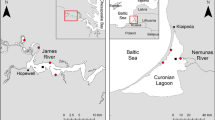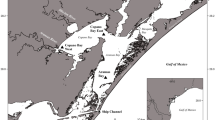Abstract
Particulate organic matter (POM) plays an important role in nutrient dynamics in river ecosystems, but little is known about changes in the origin and quality of POM in relation to physical and seasonal changes along rivers. Using stable isotope and stoichiometric analyses, we investigated the changes in origin and quality of POM of three different size fractions (fine [FPOM], 1.2–100 μm; medium [MPOM], 100–250 μm; and coarse [CPOM], 250–1,000 μm) at 14 sites along a gravel-bed river over four seasons. FPOM and MPOM accounted for 90% of all POM at all study sites. At each site, the δ13C level was lower for FPOM (range: −29.0 to −21.1‰) than for MPOM (−26.9 to −17.2‰) and CPOM (−27.5 to −16.3‰). The C:N ratio was lower for FPOM (6.9–15.6) than for MPOM (6.3–17.4) and CPOM (5.7–27.1). The contribution of periphyton to POM of all size fractions had a tendency to increase downstream, though the trend was less clear and varied seasonally for MPOM and CPOM between sites in middle and downstream reaches. Contrastively, the C:N ratio in all size fractions of POM consistently decreased downstream. The downstream decrease in the C:N ratio of POM can be partly explained by the increase in the contribution of periphyton, which seems to be associated with increased discharge and enhanced periphyton dislodgement, especially in winter. In addition, an increase in bacterial biomass associated with the greater nutrient availability in pool areas is another possible reason for the decrease in the C:N ratio of POM downstream.



Similar content being viewed by others
References
Akamatsu, F., H. Toda & T. Okino, 2004. Food source of riparian spiders analyzed by using stable isotope ratios. Ecological Research 19: 655–662.
Akamatsu, F., M. Yamamoto, Y. Chikaraishi & H. Toda, 2010. Evaluation of algal contribution to aquatic insects based on 13C/12C and C/N ratios. Researches in Organic Geochemistry 26: 107–114.
Atkinson, C. L., S. W. Golladay, S. P. Opsahl & A. P. Covich, 2009. Stream discharge and floodplain connections affect seston quality and stable isotopic signatures in a coastal plain stream. Journal of the North American Benthological Society 28: 360–370.
Biggs, B. J. F. & H. A. Thomsen, 1995. Disturbance of stream periphyton by perturbations in shear stress: time to structural failure and differences in community resistance. Journal of Phycology 31: 233–241.
Bilby, R. E. & G. E. Likens, 1980. Importance of organic debris dams in the structure and function of stream ecosystems. Ecology 61: 1107–1113.
Cai, Y., L. Guo & T. A. Douglas, 2008. Temporal variations in organic carbon species and fluxes from the Chena River, Alaska. Limnology and Oceanography 53: 1408–1419.
Castillo, M. M., G. W. Kling & J. D. Allan, 2003. Bottom-up controls on bacterial production in tropical lowland rivers. Limnology and Oceanography 48: 1466–1475.
Delong, M. D. & J. H. Thorp, 2006. Significance of instream autotrophs in trophic dynamics of the Upper Mississippi River. Oecologia 147: 76–85.
Doucett, R. R., G. Power, D. R. Barton, R. J. Drimmie & R. A. Cunjak, 1996. Stable isotope analysis of nutrient pathways leading to Atlantic Salmon. Canadian Journal of Fisheries and Aquatic Sciences 53: 2058–2066.
Edwards, R. T., 1987. Sestonic bacteria as a food source for filtering invertebrates in two southeastern blackwater rivers. Limnology and Oceanography 32: 221–234.
Edwards, R. T. & J. L. Meyer, 1987. Bacteria as a food source for black fly larvae in a black water river. Journal of the North American Benthological Society 6: 241–250.
Elser, J. J., W. F. Fagan, R. F. Denno, D. R. Dobberfuhl, A. Folarin, A. Huberty, S. Interlandi, S. S. Kilham, E. McCauley, K. L. Schulz, E. H. Siemann & R. W. Sterner, 2000. Nutritional constraints in terrestrial and freshwater food webs. Nature 408: 578–580.
Findlay, S., J. L. Meyer & R. Risley, 1986. Benthic bacterial biomass and production in two blackwater rivers. Canadian Journal of Fisheries and Aquatic Sciences 43: 1271–1276.
Finlay, J. C., 2001. Stable-carbon-isotope ratios of river biota: implications for energy flow in lotic food webs. Ecology 82: 1052–1064.
Fischer, H. & M. Pusch, 2001. Comparison of bacterial production in sediments, epiphyton and the pelagic zone of a lowland river. Freshwater Biology 46: 1335–1348.
Gordon, N. D., T. A. McMahon, B. L. Finlayson, C. J. Gippel & R. J. Nathan, 2004. Stream Hydrology: An Introduction for Ecologists. John Wiley & Sons, West Sussex, UK.
Greenwood, J. L., A. D. Rosemond, J. B. Wallace, W. F. Cross & H. S. Weyers, 2007. Nutrients stimulate leaf breakdown rates and detritivore biomass: bottom-up effects via heterotrophic pathways. Oecologia 151: 637–649.
Gulis, V. & K. Suberkropp, 2003. Leaf litter decomposition and microbial activity in nutrient-enriched and unaltered reaches of a headwater stream. Freshwater Biology 48: 123–134.
Gulis, V., A. D. Rosemond, K. Suberkropp, H. S. Weyers & J. P. Benstead, 2004. Effects of nutrient enrichment on the decomposition of wood and associated microbial activity in streams. Freshwater Biology 49: 1437–1447.
Hall, R. O., C. R. Peredney & J. L. Meyer, 1996. The effects of invertebrate consumption on bacterial transport in a mountain stream. Limnology and Oceanography 41: 1180–1187.
Japan Meteorological Agency, 2009. Climatic Statistics. http://www.jma.go.jp/jma/index.html.
Jones, S. E. & M. A. Lock, 1993. Seasonal determinations of extracellular hydrolytic activities in heterotrophic and mixed heterotrophic/autotrophic biofilms from two contrasting rivers. Hydrobiologia 257: 1–16.
Kaiser, E., D. B. Arscott, K. Tockner & B. Sulzberger, 2004. Sources and distribution of organic carbon and nitrogen in the Tagliamento River, Italy. Aquatic Sciences 66: 103–116.
Kawaguchi, Y. & S. Nakano, 2001. Contribution of terrestrial invertebrates to the annual resource budget for salmonids in forest and grassland reaches of a headwater stream. Freshwater Biology 46: 303–316.
Kobayashi, S., F. Akamatsu, K. Amano, S. Nakanishi & Y. Oshima, 2011. Longitudinal changes in δ13C of riffle macroinvertebrates from mountain to lowland sections of a gravel-bed river. Freshwater Biology. doi:10.1111/j.1365-2427.2011.02582.x.
Megens, L., J. van der Plicht, J. W. de Leeuw & F. Smedes, 2002. Stable carbon and radiocarbon isotope compositions of particle size fractions to determine origins of sedimentary organic matter in an estuary. Organic Geochemistry 33: 945–952.
Mills, G. L., J. V. McArthur & C. P. Wolfe, 2003. Lipid composition of suspended particulate matter (SPM) in a southeastern blackwater stream. Water Research 37: 1783–1793.
Miyasaka, H. & M. Genkai-Kato, 2009. Seasonal change in the gut clearance rate of three stonefly species in a Japanese stream. Ecological Research 24: 231–234.
Naiman, R. J., J. M. Melillo, M. A. Lock, T. E. Ford & S. R. Reice, 1987. Longitudinal patterns of ecosystem processes and community structure in a subarctic river continuum. Ecology 68: 1139–1156.
Peters, G. T., E. F. Benfield & J. R. Webster, 1989. Chemical composition and microbial activity of seston in a southern Appalachian headwater stream. Journal of the North American Benthological Society 8: 74–84.
Peterson, B. J. & B. Fry, 1987. Stable isotopes in ecosystem studies. Annual Review of Ecology and Systematics 18: 293–320.
Sterner, R. W. & J. J. Elser, 2002. Ecological Stoichiometry: The Biology of Elements From Molecules to the Biosphere. Princeton University Press, Princeton, NJ, USA.
Thorp, J. H. & M. D. Delong, 1994. The riverine productivity model: an heuristic view of carbon sources and organic processing in large river ecosystems. Oikos 70: 305–308.
Triska, F. J., V. C. Kennedy, R. J. Avanzino, G. W. Zellweger & K. E. Bencala, 1990. In situ retention-transport response to nitrate loading and storm discharge in a third-order stream. Journal of the North American Benthological Society 9: 229–239.
Uehlinger, U., H. Bührer & P. Reichert, 1996. Periphyton dynamics in a floodprone prealpine river: evaluation of significant processes by modeling. Freshwater Biology 36: 249–263.
UNESCO, 1966. Determination of photosynthetic pigment in seawater. In UNESCO (ed.), Monograph on Oceanographic Methodology. UNESCO Press, Paris: 66 pp.
Vannote, R. L., G. W. Minshall, K. W. Cummins, J. R. Sedell & C. E. Cushing, 1980. The river continuum concept. Canadian Journal of Fisheries and Aquatic Sciences 37: 130–137.
Wallace, J. B. & R. W. Merritt, 1980. Filter-feeding ecology of aquatic insects. Annual Review of Entomology 25: 103–132.
Walters, D. M., K. M. Fritz & D. L. Phillips, 2007. Reach-scale geomorphology affects organic matter and consumer δ13C in a forested Piedmont stream. Freshwater Biology 52: 1105–1119.
Webster, J. R. & J. L. Meyer, 1997. Stream organic matter budgets. Journal of the North American Benthological Society 16: 3–13.
Yoshimura, C., M. O. Gessner, K. Tockner & H. Furumai, 2008. Chemical properties, microbial respiration, and decomposition of coarse and fine particulate organic matter. Journal of the North American Benthological Society 27: 664–673.
Yoshioka, T., 1997. Phytoplanktonic carbon isotope fractionation: equations accounting for CO2-concentrating mechanisms. Journal of Plankton Research 19: 1455–1476.
Zeug, S. C. & K. O. Winemiller, 2008. Evidence supporting the importance of terrestrial carbon in a large-river food web. Ecology 89: 1733–1743.
Acknowledgments
We thank the Toyohashi Office of River and the Shitara Dam Construction Office of the Ministry of Land, Infrastructure, Transport, and Tourism for their cooperation and research support. We also thank K. Nakata, M. Fujiwara, and Y. Yajima for help with the fieldwork. We are grateful to two anonymous reviewers for their valuable suggestions and critical comments. This study was funded by the Ise Bay Eco-compatible River Basin Research Project of the Council of Science and Technology Policy, Ministry of Education, Culture, Sports, Science, and Technology, Japan.
Author information
Authors and Affiliations
Corresponding author
Additional information
Handling editor: Judit Padisak
Rights and permissions
About this article
Cite this article
Akamatsu, F., Kobayashi, S., Amano, K. et al. Longitudinal and seasonal changes in the origin and quality of transported particulate organic matter along a gravel-bed river. Hydrobiologia 669, 183–197 (2011). https://doi.org/10.1007/s10750-011-0682-8
Received:
Revised:
Accepted:
Published:
Issue Date:
DOI: https://doi.org/10.1007/s10750-011-0682-8




